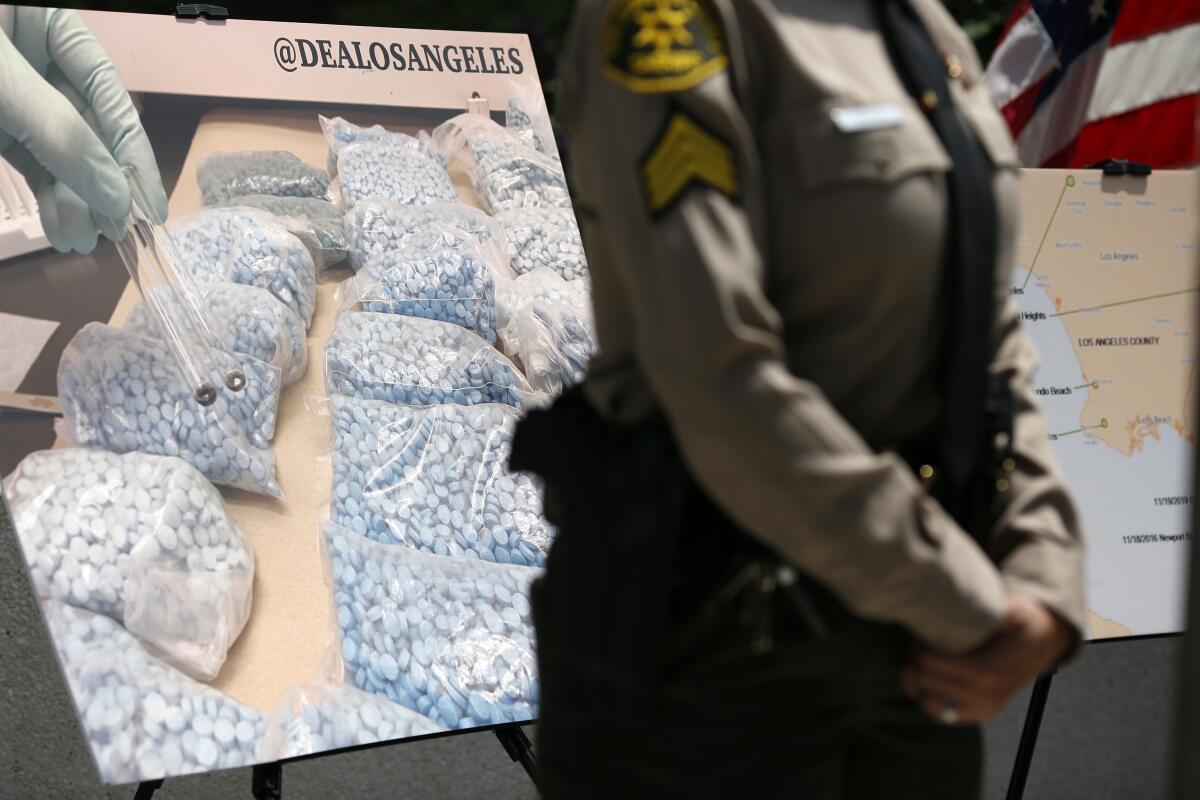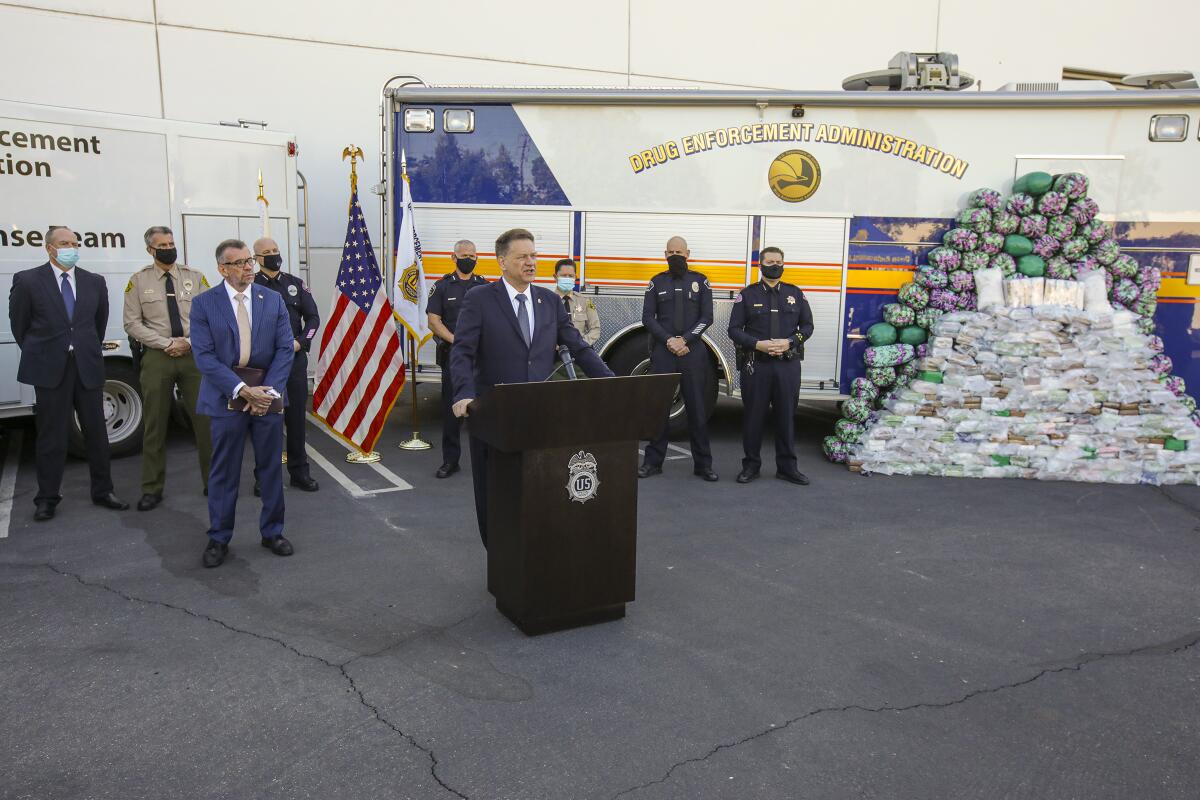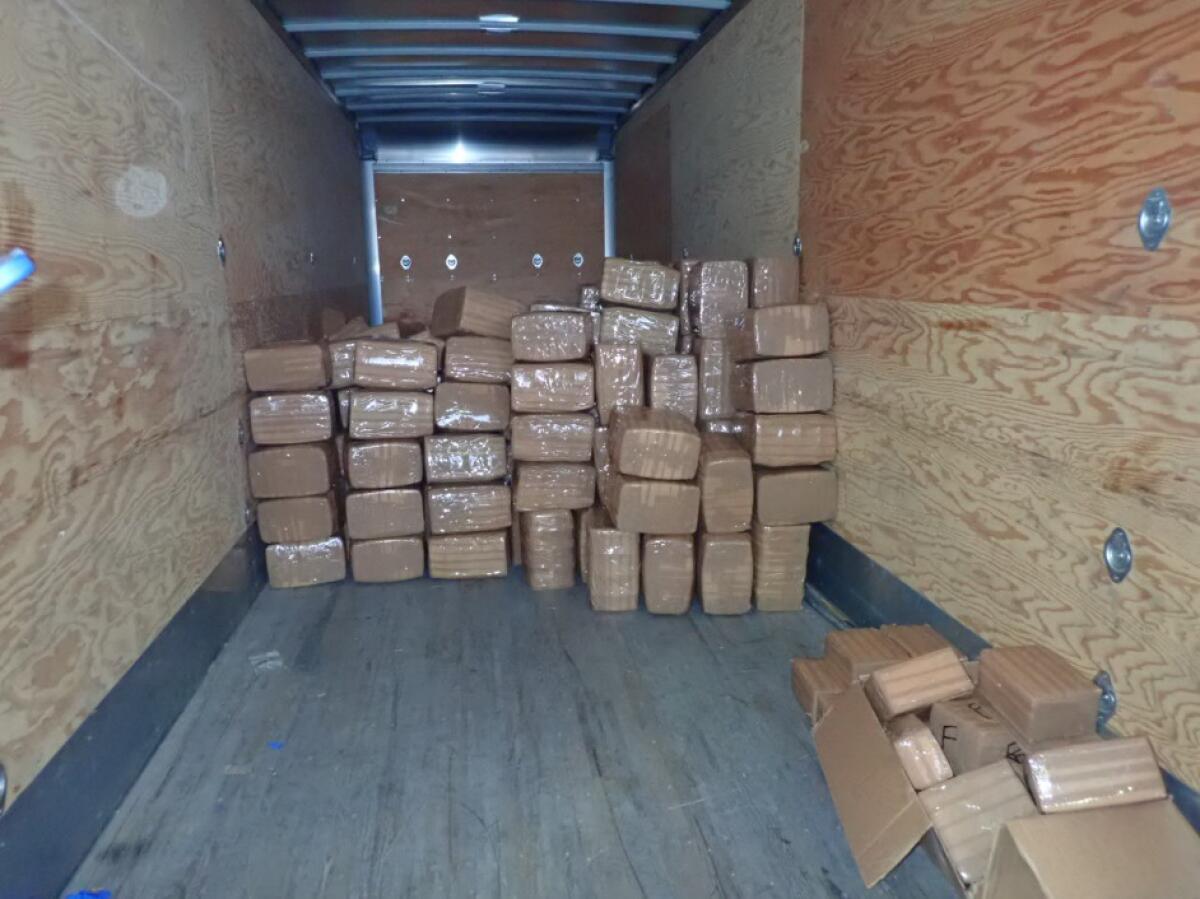How drug overdose deaths surpassed 100,000 in one year

- Share via
The drug crisis that has gripped the U.S. for years hit a milestone during the pandemic. More than 100,000 Americans died of overdoses in the one-year period leading up to April, an almost 30% jump from the prior year, according to data released this week by the National Center for Health Statistics. That startling figure exceeds the number of traffic and gun fatalities combined.
How did that happen? The Times spoke to Sam Quinones, who chronicled the drug trade in the 2015 book “Dreamland: The True Tale of America’s Opiate Epidemic,” and most recently explored the evolution of the epidemic in his new book “The Least of Us: True Tales of America and Hope in the Time of Fentanyl and Meth.”
Quinones is a former Times reporter. This interview has been edited for clarity.
Sam, this is the first time we’ve seen the number of overdose deaths in one year exceed 100,000. It’s easy to imagine how the pandemic played a role in this surge — driving up anxiety and depression, cutting off access to treatment. But there seems to be a bit of a paradox here: a crisis that was exacerbated by COVID-19, but also obscured by it.
Yes, and also completely deflated by it. Attention to the crisis was really growing until February 2020, and then all the focus shifted — I’m not saying wrongly — to the pandemic. The problem was, it was at this very moment that the Mexican trafficking world had achieved something that no other traffickers had achieved in the history of our country: covering the country with the most deadly and mind-mangling drugs we’ve ever seen. It had been building for years towards that. It just so happened that we went into isolation at the very moment when these drugs hit their apex.
You’re talking about synthetic drugs, and particularly meth and fentanyl, which can be up to 100 times as powerful as morphine. How does the potency of these drugs play into the evolving drug crisis?
These overdose figures are unprecedented because the situation on the street is as well. Never in the modern history of drug use — so around World War II, let’s say — have you seen a need for the drug-trafficking world to mix drugs to make a profit. Not with crack, PCP, cocaine — this all comes ready to sell, right? Now, in order for the trafficking world to make the lottery-winning type of profits it expects to make, it has to mix that stuff.
They’re mixing with meth, mixing with cocaine, and now we’re seeing reports of mixing with marijuana. Everybody selling knows that you just add fentanyl to your mix — whether you’re selling cocaine or meth, it doesn’t matter — and pretty soon, you’re going to get a fentanyl addict who will buy from you every single day.
We’re living in a very, very different world. It used to be that shifts would take place over decades: the ’70s were depressants; the ’80s was crack, stimulants; the ’90s, well, you didn’t really know. And so now it’s all together and all at the same time — in catastrophic quantities.

Let me ask you about that, because, when it comes to something so addicting, I often wonder about the cyclical relationship between supply and demand. As people get hooked, it seems like the synthetic nature of these products mitigates the barriers to mass-production.
Right. You can make these year-round, provided that you have access to the chemicals. Those synthetic drugs don’t need seasons: You don’t need four months to make 50 kilos of methamphetamine, you need about a week. And if you have the chemicals, you can make those 50 kilos over and over and over and over.
With methamphetamine, it’s no longer limited by one precursor that’s difficult to replicate. You can make ghastly quantities with many different chemical procedures or hacks, right? You can make it this way, you can make it that way. The chemicals are different, but they’re all easily available, they’re all industrial, they’re legal. Of course, most of them are very toxic — but there’s lye, cyanide, hydrochloric acid, sulfuric acid. There’s many ways of making this stuff.
As a result, the price drop for methamphetamine in many regions is 80% or more. In the Nashville area, for example, methamphetamine was $12.50 for an ounce. Now it’s $2.25.
What about fentanyl?
First of all, the amount that you need to make a huge, huge profit is actually relatively small. And it’s fairly easy to make. But with fentanyl, there’s another issue. At first, it was Chinese companies sending fentanyl over right in the mail — you buy it on the dark web, and they send you a kilo. But it’s highly unlikely we’d ever be able to hit the supply of fentanyl we’re seeing now with mailed packages from China.
That quantity is due to the fact that it’s now the Mexican trafficking world making it, with those unlimited chemicals from ports on the Pacific coast of Mexico, and funneling it through border crossings among the millions of cars and trucks that cross back and forth to the United States every year. The shift was away from China to Mexico, where the chemicals are coming in in huge numbers.

Geographically speaking, if that’s where the products are coming from, where are they going? As we look at the overdose data from the past year, it seems to be touching almost every corner of the U.S.
Think about this: If you drive coast to coast on the freeways, you will see that corporate America has provided almost identical offerings all across the country. It doesn’t matter where you are — you can find the Applebees, the Cracker Barrel, the same Hampton Inns and Motel 6s and Shell gas stations.
That’s what the Mexican trafficking world has achieved with these two drugs in particular — fentanyl and methamphetamine. You can get them in Kentucky, you can get them in Los Angeles, you can get them in Oregon. They’ve built up vast distribution networks all across the country. That, too, is unprecedented.
So, this isn’t the mom-and-pop shop, or even the In-N-Out. It’s the McDonald’s, right?
The McDonald’s or the Walmart, yeah.
Can you speak a little bit about the the demographics we’re seeing in the overdose deaths? A lot of us still think of the crisis as primarily a rural, white issue. But these numbers are reflecting the shift toward more diverse victims.
When I wrote “Dreamland,” there were no nonwhites involved. It was remarkable for that very reason — never had we seen a uniracial drug scourge in our country, as far as I know, or certainly nothing on this scale. And it’s still largely white. that seems to me very clear.
But “The Least of Us” certainly brought African Americans into the mix for the first time in my reporting. African Americans are dying of opioid overdoses because African American dealers are figuring out the same thing as any other dealer: I can put fentanyl into my cocaine. And if I do, I’ll have a fentanyl user pretty soon. In my book, I talk about this in some depth. The chapter that I write about this focuses around the first African American guy to die in the city of Akron, which was one of the first towns to see the arrival of fentanyl. Mikey Tanner lived 10 years struggling with a cocaine addiction, but didn’t live more than a month or two after fentanyl hit the drug supply.
It was years ago — in the early days of fentanyl — but it portended something larger, which was that the drug dealers in the African American community, like every other drug dealer across America, were beginning to figure out that if you added fentanyl to whatever you’re selling, you get a far, far more faithful customer. The negative, of course, is that you occasionally get a dead body.
It’s what most likely happened to the comic in Venice Beach in early September, and most likely happened to Michael K. Williams, the great actor from “The Wire.” People initially think they’re on cocaine, and they die on this stuff.
I’m curious how you think federal or state responses will need to change in light of this new data. There’s long been a lot of hype about increasing access to naloxone and promoting its use. But what’s your view regarding how best to address this — cracking down, or easing up?
I’m afraid to respond to this question, because I’d have to go on for a while. And not because I have all the answers. But the idea of decriminalizing drugs — when those drugs are fentanyl and meth — seems to me to be the height of misguided compassion. It’s not kind and merciful, it’s a death sentence, and it’s truly devastating.
The drugs have changed, but our thinking hasn’t. Philosophies that were born of another drug era have to be reassessed; the idea that there is no role for law enforcement in all this is foolhardy.
The time has come to understand: There is no achieving readiness for treatment when you’re on the street addicted to fentanyl and synthetic meth. You’ll never be ready for treatment before those drugs kill you. Eventually, fentanyl will kill everybody who uses it.
More to Read
Sign up for Essential California
The most important California stories and recommendations in your inbox every morning.
You may occasionally receive promotional content from the Los Angeles Times.











